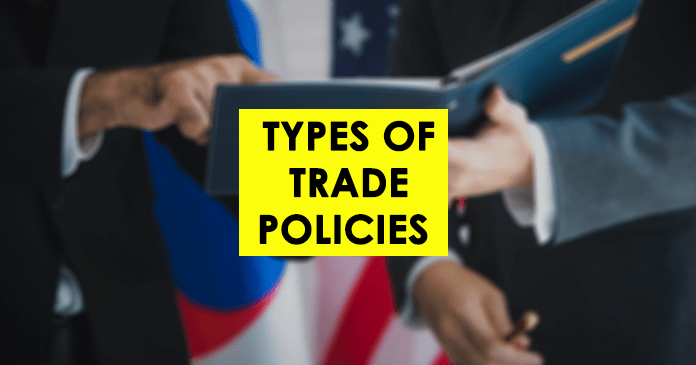Types of Trade Policies: Trade policies are mainly divided into two as outward oriented and inward oriented strategies.
Trade policy is a continuing conflict between the benefits of comparative advantage and the demanding of protectionists.
Free trade promises more output, greater efficiency and lower prices. At the same time, free trade threatens profits, jobs, and wealth in specific industries.
Politically, trade policy is a major trump of many political parties for their survival, especially for protecting local industries (producers) rather than consumers.
Producers of import-competing industries in USA, Japan and some European countries have a greater economic stake in influencing governments for trade restriction.
Types of Trade Policies
Trade policies in many countries are not fairly liberal. It includes trade restrictions too.
Basically, trade policy consists of the tariff, quotas, subsidies, and non-tariff barriers.
- Tariff includes taxes on exports and imports
- Government-imposed limits on the value or volume of exports or imports are known as quotas.
- Subsidies are payments made by governments to promote or prevent exports or imports.
Trade policies are mainly divided into two as outward-oriented and inward-oriented strategies.
Types of trade policies # 1.Outward oriented strategy
Outward oriented or the outward-looking strategy is neutral between production for the domestic market and exports and consumption of domestic goods and foreign goods.
So, trade and industrial policies are not discriminate for domestic and export markets. So the neutral strategy does not mean as export-oriented or export promotion strategy.
The World Bank has categorized outward strategy into four as strongly outward oriented, moderately oriented, strongly inward oriented and moderately inward oriented countries.
Types of trade policies #2.Inward oriented strategy
Inward oriented strategy discriminates against foreign goods by protecting domestic industries from foreign competition.
It does not mean that inward strategy is totally against exports, but it discourages export by following several methods.
The Potential Gains from International Trade
The theoretical base of gains from international trade can be divided two as static gains and dynamic gains.
The static gains relates with increasing production and consumption of the nation as expansion of the production possibility frontier due to international trade.
The dynamic gains relates with technological conversion and market expansion and economic development.
Although the potential gains from free trade are very clear, we should not conclude that everyone would be benefited equally from the free trade.
At present, except Hong Kong metropolitan government, all other countries of the world follow some trade restrictions while following free trade policies as the engine of growth.


